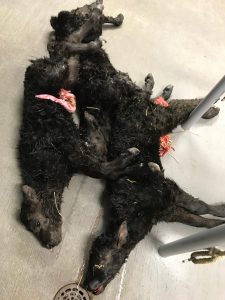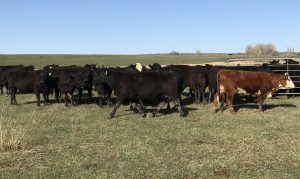Premature, Stillborn, or Dead
Bred heifers are starting to drop calves in our area. Of course, Mother Nature decided to send us some below zero temperatures and some wind, just to remind ranchers what winter can look like.
We have been seeing an unusual amount of premature and stillborn calves.
Pregnant cow nutrition pre-calving is probably the single biggest culprit in these calves, but since calving is upon us, that ship has sailed.
However, there are still a few things that producers can investigate and potentially remedy.
First off, calves out of thin cows are going to be at higher risk. The first calf and second calf heifers are often in this group just because of their age.
Colostrum out of this group is not as rich in fat, nutrients, or antibodies. This contributes to a number of causes of the weak or dead or premature calf:
1. Hypothermia: Fat in the colostrum is critical in regulating the body temperature of calves. So first, the calf has to be in good enough shape to stand and suck. Then when the calf does suck, that colostrum has to have a high enough energy content to keep that calf from getting cold.
What can you do if you suspect that the colostrum is low quality, or if the calf can’t get up to suck? Use a colostrum REPLACER. Make sure you are buying replacer and not supplement. The replacer is about twice as concentrated as the supplement. So the calf is getting more immunoglobulins and more nutrients, in a much small volume. The price different is about $10-15 more for replacer than supplement. But it could make the difference between life and death.
2. Vitamin A and E: The calf is not born with these vitamins. They need to consume large quantities of them in the colostrum right after birth. They are responsible for vision, muscle growth and function, among other things. Testing for levels of these minerals in the calf that hasn’t sucked yet gives us little to no information. We need to get blood samples from the dam, or samples from the calf AFTER it has sucked.
You can give an injection of Vitamin EAD at birth to calves.
**If you are giving an injectable scour guard to calves, you do NOT want to give these two shots together.**
3. BVD: We saw a number of calf losses last year due to BVD. If you have a dead, sick, or premature calf, take a piece of the ear and put it in a ziplock bag. Write the cow and calf ear tag number and put it in your freezer. You will want to submit these for testing. You do not want to find out in the late summer or fall that you have BVD in your herd!
4. Trace Mineral Status: I also like to take a piece of liver of anything that dies on the ranch. The liver will tell us what your trace mineral status is. This is true even if you are paying big bucks for a mineral package and think that there is no way you could be deficient.
We had one herd with calving issues already this year that was due to precipitously low copper levels. The whole herd had been on a fantastic mineral package all year. It ended up that the cows were drinking from a surface water source that was tying up the trace minerals. Injections of multi-min at key points during the year will help avoid this issue.
If you are having issues, our veterinarians are always happy to investigate. Call us if you have any questions!
Brucellosis Update: Rule Change For Big Horn County
If you missed the meeting on Tuesday, here is what was discussed regarding the proposed rule change that will make brucellosis vaccination (aka “bangs vaccination”) mandatory in Big Horn County, MT.
The rule basically requires that female cattle 1 year and over be bangs vaccinates.
As the state vet pointed out during the meeting, almost every producer already bangs vaccinates their replacement heifers. They are vaccinated as calves between the ages of 4 months and 12 months old.
If there are cows over the age of 1 year old that have not been bangs vaccinated, they will need to be vaccinated as adults. Cows vaccinated as adults will receive a silver tag instead of the standard orange tag. Also, they must be vaccinated when they are NOT pregnant of course.
The reason for the rule change is due to the migration pattern of brucellosis positive elk from Big Horn County, Wyoming. This is a surveillance area that is just to the south of our county. Elk have been seen moving into areas of our county in early spring. Luckily, there don’t tend to be many cattle present in this particular area at this time of year. The Crow tribe does have buffalo in this area, and they are working with the state vet to vaccinate their buffalo that might be exposed.
The rule will be enforced during change of ownership. So basically, any female over the age of 1 year old will need to be checked for bangs tattoo and tag before she can be sold. This rule will not affect calves less than 1 year old going for feeding.
If you have any comments, this rule change is open for comments until this Friday at 5 pm.
Dart Gun Update
Over the past few years, dart guns have been growing as a popular, low-stress way to give Draxxin.
Draxxin is low volume and not as thick as other medications so in many cases, producers are reaching for this medication over higher volume, thicker antibiotics such as LA 300.
With emerging concerns over appropriate use of antibiotics, including issues like drug resistance and beef quality, many beef veterinarians have been hesitant to recommend a remote drug delivery system under any circumstances.
Recent research have minimized some of veterinarians’ biggest concerns.
Dr. Amelia Woolums presented some of this research this past weekend.
She showed that Draxxin reaches similar therapeutic levels as when it was given with a syringe under the skin.
However, similar to a previous study, failure of the dart to actually discharge can be a problem, particularly if an air gun is used (vs. CO2).
The producer is unlikely to realize that the dart did not discharge as they would have to weigh the dart both before delivery and after it fell out of the animal in the field.
Another concern is that the darts may cause muscle injury. More good news for dart guns here as Dr. Woolum found that the darts did not appear to cause significantly more muscle injury than an injection under the skin.
Take Home Points for producers using dart guns to deliver draxxin:
Make sure you are the proper distance from the target (generally 25-35 feet depending on the projector).
If you are too close, you risk entering the muscle. If you are too far, you risk not penetrating the skin completely.
Aim for the center of neck for purposes of beef quality assurance.
Use a big enough needle (14 gauge 3/4 inch needle with single port and gel collar)
Make sure you purchased the right charges (ie. do not use the black ones that are used for concrete).
Which DeWormer Should I Use This Spring?
The Question
Is long range still a cost effective dewormer compared to brand name ivermectin? This is a question that veterinarian Dr. Calvin Booker set out to answer recently.
How Is This Research Applicable to Cow Calf Producers in Big Horn County
I like this study because it was done in country similar to ours here in eastern Montana. It analyzed total pounds gained relative to the cost of the dewormer. The animals used in the study were yearlings on pasture and not cows. However, the study demonstrates that long range is still an effective dewormer in our part of the country.
The Methods of the Study
The study was done on 3,000 head of stocker steers in neighboring Saskatchewan. The cattle were split into two groups of 1500 head each. One group received brand name ivermectin pour-on. The other group received Long Range.
After 157 days on grass, the cattle were weighed and and the value of the product was calculated based on a sale value of $185 / 100 lb at an average weight of 943 lbs.
Results
Steers receiving long range gained 23 lbs more than their counterparts that received Ivermectin pour-on. This translated to $19.11 / head profit in the long range cattle.
Dr. Bialon Has the Last Word
Long range peaks at administration and then again at 80 days. It maintains therapeutic levels for up to 150 days.
There are always questions on whether long range is worth the price tag. I ask myself the same question every year when my husband and I are discussing what products to use on his herd. For us, its a question of the cost per head, and also the amount of labor that goes into working the cows (specifically giving them shots) at branding.
We are using Long Range again this year. The product is a no-brainer in the replacement heifers that will be going out with bulls for the first time. Its convenient because we are giving them vaccinations and multi-min anyways 30 days before bull turn out.
The adult cows take a bit more consideration. There are a lot more of them. However, I feel that we are accomplishing a number of things with this product.
Its still an efficacious product that is working in terms of killing parasites.
We feel that we are achieving horn fly control.
Our pregnancy rates have dramatically improved in the two years since using the product. I don’t know why. There are a number of possible explanations for this, but at the end of the day, the cows are in better shape than ever.
In short, we will be using Long Range on our herd this spring. Whatever product you choose, just remember to give the correct dose to your livestock. Under dosing dewormer is not doing much except contributing to resistance. Don’t squirt those cows as they run through the sorting gate. Take the time to do the job right.
Unusual Parasites Cause Death In Replacement Heifers
It has been a hard winter for replacement heifer calves. We have seen a number of deaths in 700 lb weight calves over the last month.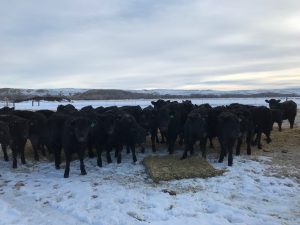
Most of these calves were home-raised replacement heifers and cut-back steer calves that were being backgrounded at home.
While respiratory disease was implicated in all of the cases (based on autopsies and lab samples), we found some surprising results in the fecal samples. Parasites were at the root of all of the disease and death that we were seeing in these cases.
It wasn’t just any parasite though. Two very unique parasites were affecting these herds: Nematodirus and Tape worms.
Neither of these parasites tend to cause problems in cattle over 2 years old. But they can wreak absolute havoc on young stock.
Also, they are not killed by traditional dewormers like Ivermectin or Dectomaxx. Both worms can be killed by the oral white wormers (like Valbezan). And certain pour ons such as Cydectin and Eprinex can kill the Nematodirus (but not tapeworms).
Within 24 hours of treating their 700 weight calves for these parasites, these producers reported that their calves were entirely different animals (bucking, playing, eating).
Most surprising of all, was that most of these calves were fat and healthy with beautiful hair coats. They showed none of the symptoms of parasitism.
What does this mean for your herd?
Run fecals! We have a special fecal centrifuge at our clinic designed specifically to isolate parasites. Our veterinarians and licensed technicians can tell you if your poop looks clean in a matter of a few hours.
How To: Collect fresh feces in a ziplock bag. Label with the ear tag number. Drop off at our clinic within 24 hours (keep in fridge if posssible). Take 5 samples from your replacement heifers. Take 1-3 samples from your bulls. Take 1-3 samples from your coming 3 year olds.
If a critter dies, have her autopsied within 24 hours!! Don’t wait for a second animal to die before you decide to pursue diagnostics.
Autopsies almost always give you answers. More often than not, its not the answer that you expected.
Vaccine protocols and deworming protocols can then be adjusted accordingly.
Nematodirus worms produce a distinctive, large, football-shaped egg. You can see how much larger the nematodirus eggs are in this slide vs. the other “normal” sized stomach worms.
Tapeworm eggs are about 1/3 of the size of nematodirus. 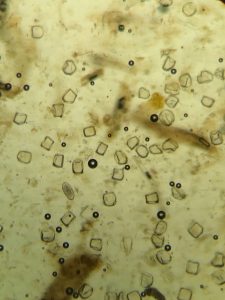
Call The Sugar Factory Vet Clinic if you have any questions regarding your herd!
Lice Update: My Cows Are NIT Going Bald This Year!
Imagine this. Its the first of March and your cows are starting to go bald. I’m not talking about the small bald patches around the face caused by ringworm that you see in younger animals. I’m talking about massive losses of hair on the bodies of most of your cows. They are obviously uncomfortable and rubbing on everything in site.
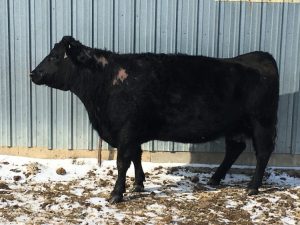 This is chewing lice. Lots of chewing lice… each cows probably has 10 or more lice per square inch of their body. This level of chewing lice can certainly cause reduced weight gains. Lower levels can cause economic losses that are perhaps not as quantifiable (damage to fencing and equipment from rubbing).
This is chewing lice. Lots of chewing lice… each cows probably has 10 or more lice per square inch of their body. This level of chewing lice can certainly cause reduced weight gains. Lower levels can cause economic losses that are perhaps not as quantifiable (damage to fencing and equipment from rubbing).
“That expensive pour-on I bought isn’t working! All my cows have lice!” This is the complaint that I hear frequently.
But this is not an issue of resistance. The main problem is that the pour-ons that we use for internal parasites aren’t designed to kill chewing lice. Even if a product labeled for chewing lice was used, producers are generally pouring their cattle in the fall. This is way beyond the duration of efficacy.
“But doc, the label says that this pour-on kills four species of lice!”
The lice that our most popular pour-ons kill are primarily SUCKING lice. The species of lice that causes the most problems in our cattle herds are CHEWING lice. The label should state that the product controls chewing lice or Bovicola bovis specifically.
NITS are the source of our problems
Here is the real kicker. Most lice products require TWO treatments. This is because most lice products only kill ADULT lice. The cows are still full of sticky eggs (nits) that will hatch again in 14 days.
For this reason, I recommend using a lice product (Clean up 2) that contains an IGR. This 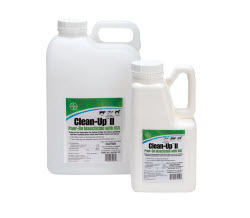 type of lice product only requires one application because it kills adults and the nits. Also, the product should generally be applied in January or February. This time frame may change depending on when you are seeing lice in your herd.
type of lice product only requires one application because it kills adults and the nits. Also, the product should generally be applied in January or February. This time frame may change depending on when you are seeing lice in your herd.
You certainly don’t want to wait until cattle are actually showing hair loss to treat. At this level, the economic losses are already occurring and treatment become less effective.
The time you want to initiate lice treatment is when there are 1-2 lice per square inch on your cow. I don’t actually expect that I’ll see many producers counting lice, but that is ideal. Next time your cow is in the chute, try it.
If you have any questions, stop by our livestock supply store. Let us help you select a product that will be effective in your operation.
“Winter” Pink Eye in Calves and Yearlings
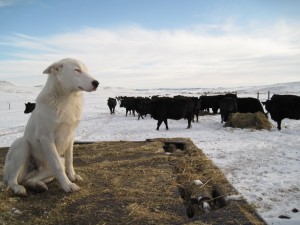
We have seen a recent run of “winter” pink eye in calves this year. Pinkeye is also know as Infectious Bovine Keratoconjunctivitis, or IBK.
These calves are showing up with the classic symptoms of a discreet round ulcer in the middle of the eye, accompanied by tears, squinting, and a bluish haze to the eye (which is edema). A few herds have experienced concurrent respiratory symptoms and fever, as well as decreases in weight gain.
History
The majority of these calves have been pre-conditioned and well vaccinated as a lot of them are destined to be replacement heifers. Affected calves are born out of cows of all ages -so they are not necessarily out of the young cows with less immunity than their solid mouth counterparts.
Not Just A Poke In The Eye
Many producers have expressed concern that theses calves are simply getting poked in the eye by stemmy feed stuffs. They have pointed out the lesions in the eye to me as evidence that it looks exactly like they were poked in the eye. Many of the organisms that cause pinkeye contain an actual toxin that damages the cornea and gives the appearance of a puncture wound. So while a piece of hay or other foreign material could poke a calf in the eye and initiate a bout of pinkeye, it is not strictly necessary. Read More >
Puppy Tooth That Didn’t Fall Out
Just like in humans, a dog’s puppy teeth should fall out when their adult teeth erupt. Sometimes, the puppy teeth do not fall out, and we refer to them as “retained deciduous teeth”.
Puppy Teeth Can Stop Jaw Growth
“Penny” is a 2 month old Shih Tzu cross that was having problems eating hard food. When she came in for her dog grooming and puppy shots, one of her bottom canine teeth was in the wrong position and was poking a hole in her palate! The baby tooth is not only very sharp and causing Penny a lot of discomfort, but it is essentially locking her bottom jaw into place. Jaws have growth plates just like any other bone. When the jaw is locked into position every time Penny closes her mouth, the growth plate is also locked into position, and the jaw is unable to grow to its proper length.
Pet Hazards
Ibuprofen is particularly toxic to dogs and cats. Do not give ibuprofen to your dog or cat under any circumstances. If your dog or cat accidentally ingests ibuprofen, contact us immediately. Read More >



